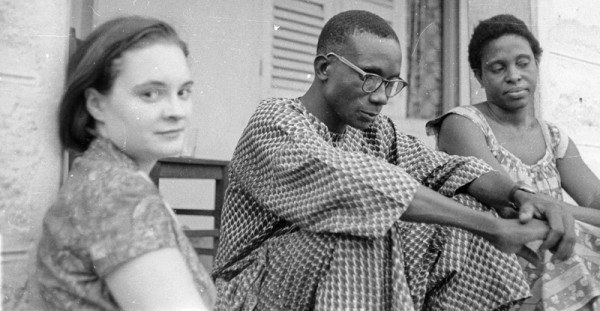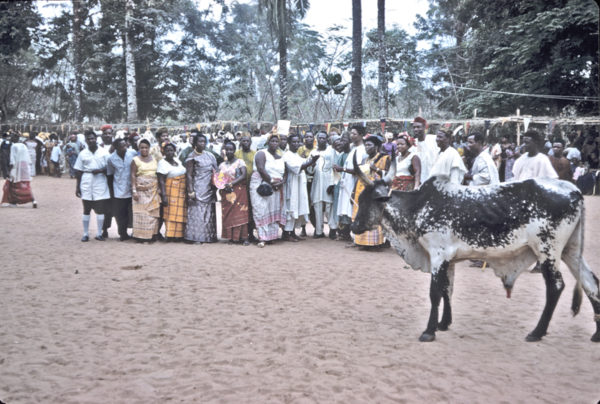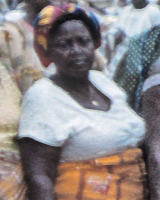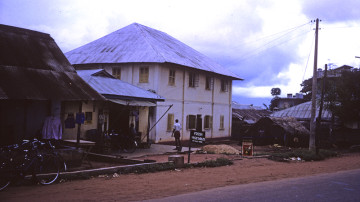
[Note: Click on any image you may want to enlarge.]
Here, let me introduce my longest-term research aide while we worked in Onitsha 1960-62.
Some features of Byron’s life are highly relevant to our story. Byron’s mother, Priscilla, was a daughter of the legendary Reverend G.N. Anyaegbunam of Umu-Ase Village (or Umu-Asele, “Children of Ase”), the first Igbo-speaking person to be ordained a CMS Minister in Nigerian history, and his wife Esther Obianwu, a daughter of another prominent early Onitsha Protestant, S.C. Obianwu of Obikporo Village (who eventually took the title of Owelle, 6th Senior Chief of Onitsha). (Esther herself played a prominent role among Onitsha women in relation to early 20th-century Onitsha market trade. 1.
When Priscilla married Benedict Maduegbuna, the young man found himself heavily pressured to live a Christian life, and so he gave up his position as a court official for the Government and as rightful senior priest of Isiokwe Village, and travelled around Nigeria with his wife as a teacher for the CMS. (Because of his strong commitment to the Anglican Church of his day, he never took the Ozo title, and this policy has been followed as well by his offspring, though his son Byron was not happy about this fact; at one point he referred to this social condition as a family “stain”).
Priscilla eventually became prominent in Onitsha social life. An active member of the Onitsha Women’s Branch of the NCNC, she may be seen here below together with other prominent members of the Women’s Branch (with some of their patrons and escorts), standing near the cow they presented to the royal family for Obi Okosi’s funeral in March 1961:

 Priscilla is fourth from the left in the front row. (Toward the end of this page you will see a clearer close-up view of her with her grandchildren.)
Priscilla is fourth from the left in the front row. (Toward the end of this page you will see a clearer close-up view of her with her grandchildren.)
As small children, Byron and his older brother Peter were placed in Reverend Anyaegbunam’s charge during this time. A schoolmaster periodically transferred to various stations in Southern Nigeria, the Reverend and his wife ran what appears to have been a somewhat Kibbutz-like child training program, raising as many as 50 children in a rigorously Christian discipline that was age-graded according to task abilities, communal in sharing children’s property, and which provided strict training for stamina, cooperative work responsibility, and Biblical knowledge.
The following two paragraphs provide a biref elaboration (from the notes I took from Byron):
The children were age graded, boys sleeping in one section, girls in another. Rev. Anyaegbunam was a patriarch with great mystique: they called him “Pa”. Other relatives were called sis and bro (even aunts and uncles). Children of all sizes got strict responsibility training: for example, pots of various sizes,holding water according to the size of the children, were lined up and each child had to fetch an amount appropriate to age, from the time they could walk. Eating was done in highly regimented fashion, food distribution being the basic sanction for completing assigned tasks or fulfilling discipline. Food distribution was announced by bell and children would run about with plates, given food according to one’s physical size. The children were all treated as equal but there was little time allowed for interaction. They were given “ordeals” at 12, stamina training: required to remove sandals and go barefoot into the forest. Rote learning of the Bible was powerfully stressed: according to age, the children had to go and recite before “Pa”, whether they understood what was said or not. Clothing was communal property, according to size, handed down from child to child. No child was to discriminate against another concerning relationship to “Pa” or to town of birth.
For some years Byron regarded his grandparents as his “Papa” and “Mama”, and as an adult product of this training program he displayed a rather compulsive reliability in his performance of social duties, the quality which had gained him a remarkable reputation for trustworthiness in dealing with people of diverse backgrounds (and which presumably led knowledgeable Onitsha people to insert him into our lives early in our residence there).
For Helen and me his presence was a boon beyond measure — our previous, initial “guide-escort” into the community was a man widely distrusted (nad this was quickly conveyed to us by a variety of early contacts),. while everyone knew Byron for who we was and that understanding opened many doors for us which would otherwise have been closed. 2
His mother’s mother’s brother S.C. Obianwu (who from 1923-33 acted as one of the two African Representatives on the Nigerian Legislative Council) was another major figure in Byron’s life: while Byron’s own father gave him the names “Samuel Akudo” (which I never heard anyone use in reference to him), Obianwu bestowed the name on him of the great English poet, saying he foresaw a person of impressive literary bent, and this was the name that had stuck. Byron took this identification very seriously, and when we knew him his academic titles included holder of Higher School Certificate, General Certificate of Education (Advanced Level), L.L.B. (Inter) and Bs.C (Inter Econs) (both of the latter obtained through correspondence). He had ambitions to attend the University of London (though his family lacked the money to send him abroad). Taking Nnamdi Azikiwe (his mother’s sister’s husband and a regular visitor to his house when His Excellency was in town) as his main role model, he told me he hoped eventually to become an anthropologist as Zik had done during his education in America.

So in part Byron in part regarded his work with Helen and me part as of an apprenticeship toward attaining this long-term aim.
Another noteworthy dimension of Byron’s position, however, was his deep involvement with and commitment to what he saw as “Onitsha tradition”, his active participation in the affairs of Isiokwe Village and identification with the traditional politics and ritual of the Inland Town. Though he was well read in radical nationalist perspectives (and somewhat sympathetic to them at the national level), in Onitsha Inland Town affairs he took the side of Isiokwe elders against the “radical” proposals being offered by its “young Turks”, and he aimed eventually to take the Ozo title (“to wipe off the black mark of my father’s defections to Christianity”, as he put it). When he spoke of becoming an anthropologist, his aim was not to attain a broad cross-cultural perspective through involvement in other societies, but rather to study Onitsha tradition more deeply than had previously been done, and to examine it not from the perspective of a skeptical or objective analyst but in order more fully to grasp the reality of its many- sided and profound sources of power and being.
I mention these points to ground the development of our relationship in light of what follows. While no doubt one of the reasons Onitsha people initially brought Byron and us together was to have someone they trusted monitor what we strangers were “up to” (as he himself would put it), after working with us for a while and seeing that our interest in Onitsha tradition was as genuine as his own and our methods of exploring it in some cases revealing and informative to him, I think he began to trust us implicitly and to provide us with many kinds of information he thought might be useful to our research. He certainly ly did that, as you will see in other parts of this work.
After the end of the Biafra/Nigeria Civil War in 1970, I was able to re-establish contact with Byron by mail. That year he sent me this photograph of his mother posing along with Peter’s and Byron’s children:
In 2011, I sent this photo to Nne’emeka Maduegbuna (now an advisor to Obi Achebe), who contacted a grandson, Odi (also called Samuel), who says
I can indeed identify everybody in the photograph. They are from left to right as follows: Chudy Maduegbuna, Priscy Maduegbuna, Chike Maduegbuna, Ma Maduegbuna, Odi Maduegbuna, and Amaechi Maduegbuna. Chudy, Priscy, and Odi are children of Peter Maduegbuna. Chike and Amaechi are sons of Byron Maduegbuna.
Ma nnukwu, as we fondly called her, was very happy to gather us her grandchildren at the old market road homestead. Emeka has correctly identified everyone.
> To some, Madam Priscillia Ngozi Maduegbuna, a direct offspring of George Nicholas Anyaegbunam, the first igboman to be ordained a priest of the Anglican Church, was Onye nkuzi (Teacher). This had to do with the fact that she was a school teacher for many years. Nnamdi Azikiwe was one of her pupils and refers to this in his autobiography: My Odyssey. To others, Madam Maduegbuna was Mrs, a reference to her church marriage to Benedict Byron Maduegbuna, which was not very common in the early part of the last century. To us her grandchildren, she was ma nnuku meaning grandmother or big mother.
Odi (Samuel) Maduegbuna, second from the right in the photo above, now lives in New York and is a Wall Street attorney who specializes in civil rights cases. I will simply attest that he is a very impressive young man.
- Misty Bastian, personal communication). [↩]
- I weventually learned that Byron had previously escorted the remarkable political-science scholar, Richard Sklar, around Onitsha during his pre-Independence research work there; See Sklar’s landmark book on Nigerian politics in the bibliography of this webpage. [↩]
